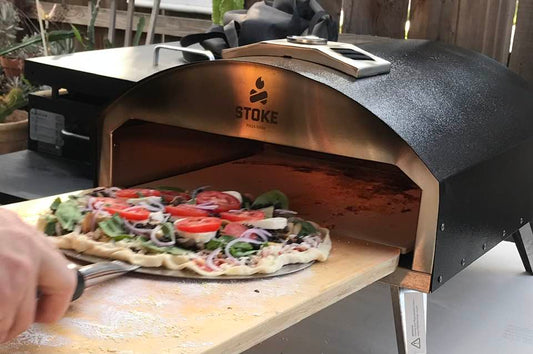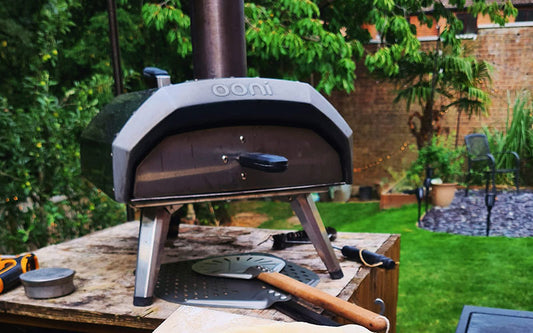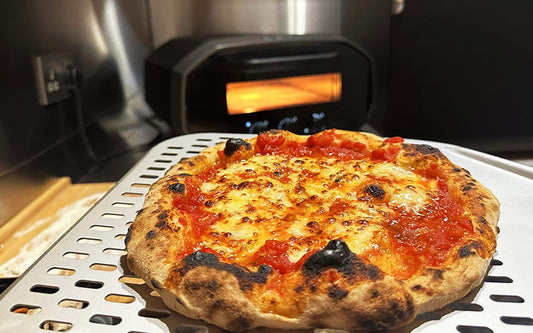Making pizza at home might not seem difficult, and I assure you, it’s not, except when it is. For instance, if your fresh pizza dough is too tacky or sticky to handle, it will make rolling out your pizza crust difficult. This can lead to uneven thickness in the finished product.
90% of the time, pizza dough consistency is affected by high hydration. Adding too much water or oil to the dough can make it sticky as hell. It will also make it difficult for the yeast in your dough to move freely, causing a slow and low rise. Seldom, using the wrong flour, kneading the dough too little, or excess humidity can also cause your pizza dough to be sticky.
If this happens, don’t worry! You can still salvage your pizza dough by adding more flour and kneading the dough a bit longer. But there is a catch. Adding too much flour can make your dough dry.
So, how do you foolproof your pizza dough? Read on to find out:
Common Reasons for Sticky Pizza Dough and Suggested Solutions
In a hurry? Take a quick glance at the table below to identify what’s causing your pizza dough to become sticky and how to troubleshoot the problem:
| Reason | Explanation | Solution |
| Too much water |
Adding excessive water to the dough leads to a very high hydration ratio. This makes the dough wet and sticky. | Reduce the amount of water. Aim for 60% hydration at first. Slowly increase the water as you gain experience. |
| Under-kneading |
Kneading develops gluten which gives dough structure. Under-kneading leads to a loose, sticky dough. | Use finely milled 00 pizza flour which has a lower absorption capacity. Adjust the hydration level for the flour type. |
| Wrong flour | Using all-purpose or bread flour can lead to stickier dough as it absorbs more water than 00 pizza flour. | Use finely milled 00 pizza flour which has a lower absorption capacity. Adjust hydration level for the flour type. |
| Inaccurate measuring | Measuring flour or water incorrectly throws off the delicate hydration ratio. | Invest in a kitchen scale and measure ingredients by weight rather than volume for reliability. |
| High humidity | Making dough on humid days can cause it to absorb excess moisture from the air. | Use a dehumidifier in your kitchen. Or avoid making dough on very humid days. |
| Sticking to peel | Putting a cold dough on a hot peel will make a dough stick. So will an inadequately floured peel. | Use two peels – one for stretching, and another for launching. Generously flour peel or use cornmeal. Also, allow the dough to come to room temp before stretching. |
Dough Too Sticky? Should I Be Worried?
Both yes and no. No, if you are familiar with the technique of handling a high-hydration dough. Yes, if you are a beginner.
Higher hydration can do wonders for your pizza crust. It not only makes stretching the dough much easier but also results in a lighter crust.
Furthermore, some believe that the leopard spots, aka the crown jewel of Neapolitan-style crusts, can only be achieved with a high-hydration dough (70-80%).
On the downside, it is not an easy task to handle such wet dough. If you are a beginner, I strongly suggest that you start with low-hydration dough (60-65%) and move up the ladder gradually while gaining experience and confidence.
The easiest way to avoid this issue is to measure your flour and water accurately. I’d strongly recommend investing in a kitchen scale and liquid measuring cup.
Baking is a science, and in science, there is no eyeballing.
5 Reasons Your Pizza Dough Is Too Sticky to Work With
Unless you are specifically aiming for a high-hydration dough, your pizza dough should be smooth and elastic but not so wet that it sticks to your hands or the countertop after a few minutes of kneading.
Below I’ve highlighted the most common reasons behind sticky pizza dough:
1. Too Much Water
This one is a no-brainer. The more water you add to your dough, the stickier it will be. If your pizza dough is too wet, try reducing the amount of water next time by 1/4 cup at a time until it’s no longer sticky. If you are a beginner, aim for 60% hydration.
If that’s still too difficult to manipulate, crank it down to 55%. Remember, you can always add more water if needed. Use Pyrex liquid measuring cup for the most accurate measurement.
2. You Didn’t Knead Long Enough
Kneading the dough helps with gluten formation, and gluten is what helps the dough hold its shape. The appropriate kneading time can vary from 10-20 minutes, depending on the hydration level of your dough. Not kneading it long enough will make the dough easier to roll and stretch.
3. You Are Using the Wrong Flour
Using the right flour is also important for proper gluten development. Most pizza recipes call for tipo 00 flour which is a finely ground flour made from durum wheat. With an average gluten content of 10-12 %, 00 pizza flour can create strong gluten and a decent amount of elasticity in the dough.
More importantly, due to the finer texture, 00 flour has a lower absorption capacity than bread and all-purpose flour. So, if you don’t calibrate the water quantity according to the flour you are using, your dough will be either tacky or dry.
4. Incorrect Flour Measurement
Flour has different densities depending on how finely it’s ground. For example, 00 pizza flour is more finely milled than all-purpose flour.
So 1 cup 00 flour won’t be the same as 1 cup of pizza flour, or bread flour, or cake flour, for that matter. That’s why measuring flour by volume will almost always result in an unreliable measurement.
5. Humidity
If you have chosen a humid day to prepare your pizza dough, be mindful of the amount of water going in it. Excess moisture in the air will also hydrate your dough during the proofing period.
So, either play safe by opting for a low-hydration dough recipe or use a dehumidifier in the room you will be using for proofing the dough.
4 Ways to Fix a Sticky Pizza Dough
First of all, stop hyperventilating. I have already established that stickiness is not a bad sign. With a little practice, you will be able to work with sticky dough like a pro.
But for now, you can try the following tips to salvage your sticky pizza dough:
1. Add some more flour
Start with two tablespoons of flour, mix, and knead it for 5 minutes; add two more tablespoons if needed. Adding the flour in small increments will help you avoid going overboard with it. Excessive flour can make your dough dry and difficult to stretch.
2. Knead the Dough Long Enough
You need to knead the dough for at least 15 minutes before jumping to any conclusion. If the dough is too tacky after 15 minutes of constant kneading, knead for 10 more minutes.
3. Use a dehumidifier
It’s the humid weather that’s making your dough too impossible to handle; find a dry and warm spot for kneading and proofing your dough. Ideally, you should use a dehumidifier in your kitchen.
4. Use a bench scraper
This is an extremely useful tool to have on hand when dealing with high-hydration, sticky doughs. Instead of using your hands, use the scraper to move the dough around on the countertop while kneading.
Pizza Dough Sticking to the Peel: Reasons and Solutions
You know, there are moments in life when you do everything right, and things still go awry at the last moment. Watching my pizza dough badly stuck to the peel is one of those moments. There are 3 common reasons for this problem.
1) The dough is too wet: No surprises there! If the dough had been sticking to every surface it has been in contact with after a decent amount of kneading; it would stick to the peel as well.
Solution: Dust the peel with coarsely ground cornmeal for best results. If you don’t have cornmeal, go with breadcrumbs, semolina flour, or the good old fashion all-purpose flour. Some chefs like to dust the pizza peel with a 50/50 mix of semolina and AP flour.
2) Humidity: A muggy day is a bad day to bake a pizza. Period. Too much moisture will turn the flour into adhesive.
Solution: Work quickly and peel your dust adequately.
3) You are using the same peel for launching and retrieving: Using the same peel for launching, rotating, and retrieving the piping hot pizza will make the peel too warm. Hot peel surface + raw dough= condensation, and condensation means trouble.
Solution: To avoid that, use a wooden peel for assembling and launching the stretched dough into the oven and a metal peel to rotate and remove it. This will ensure that the raw dough is always in contact with room temperature peel.
How to Make Pizza Dough Less Sticky Without Flour?
It’s easy to get swayed by emotions and dump too much flour into a sticky to salvage it. I have bad news for you – it’s going to ruin your pizza for good. On the bright side, there are easy and 100% fail-safe ways to make pizza dough less sticky without adding additional flour. Do the following:
- Measure all your ingredients before mixing.
- Dehumidify your kitchen if it’s a muggy day.
- Invest in a stand mixer and use the hook attachment for kneading the dough instead of your hands.
- Use a bench scraper to move around the dough when it’s on the counter. Believe me, it makes a lot of difference.
- Adequately dust your peel and use two peels to prevent condensation from messing up the dough.
Parting Words
Pizza dough is a very forgiving thing, meaning that it’s easy to recover from mistakes. If the sticky dough is giving you a hard time, adding a handful of flour will almost always fix the issue.
Keeping in mind the other tips mentioned throughout the article will further help you to avoid any mishaps. If you’re still having trouble with pizza dough, I highly recommend looking into buying a stand mixer. It will make your life much easier!




